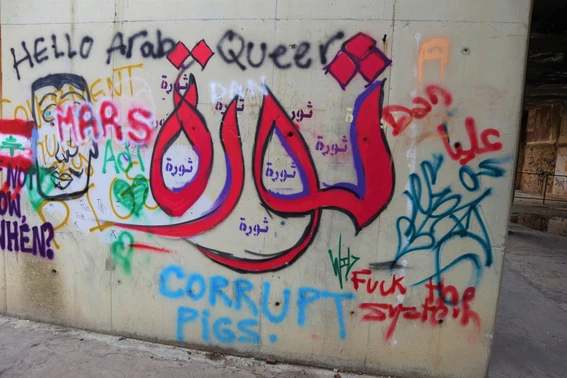Anthony Keane and Maeve Lane
A symbol of Lebanese resistance against a corrupt government
The Egg stands in the heart of Martyrs’ Square, Beirut. It looks incongruous, almost like a big, ugly concrete whale, supplanted amidst the buzz and chaos of Lebanon’s capital city. Originally designed as a cinema, The Egg was supposed to be the crowing glory of architect Joseph Philippe Karam’s “Beirut City Centre” shopping centre and office space. Unfortunately, its construction was halted by the Lebanese Civil War and for decades it lay derelict.
However, it received a new lease of life during the 2019 anti-government protests in Lebanon (which began on 17th October 2019), when it became repurposed as a cultural space, concert venue and a lecture theatre in which to discuss the politics, society and future of Lebanon. Taken over from government abandonment by university lecturers, students, civil society leaders, musicians, and other activists, the reclaiming and repurposing of The Egg as a space of enjoyment, civil society debate and unabated artistic expression stands as a true triumph of the Lebanese protests. While the thawra (revolution) of 2019 fell short in achieving its political goals, and the tragic Beirut explosion of 2020 has further devastated the country, the thawra’s achievements in the fields of reclaiming public spaces, reigniting civil society and sparking important social debates cannot be ignored. The Egg, in all of its unlovely concrete glory, is a symbol of this social triumph.

Above: Martyrs’ Square (pictured here) and the adjoining Riad al-Solh Square became the central area of the 2019 Beirut demonstrations. Campsites, stages for musicians to perform on, trucks blasting loud music, food stalls and a large fist-shaped poster with the message ‘thawra’ were all erected in the area.

Above: The ruins of The Egg are seen standing beside the construction of new office blocks. The two buildings stand in front of the Mohammad Al-Amin Mosque on Martyr’s Square. The redevelopment of the downtown area of Beirut since the Civil War, including the construction of the mosque and the office blocks, has been undertaken mainly by Solidere under the aegis of former Prime Minister Rafic Hariri, something which many Beirutis feel removed the soul and character of the city. | Below: An external facade of The Egg, adorned with colourful graffiti.


Above: A graffiti artist adorns the walls of ‘The Egg’ with a colourful mural. The topless female figure is likely a reference to the famous French Revolution (1830) painting ‘Liberty leading the People’, which depicts Liberty (Marianne), the symbolic embodiment of French revolutionary values, at the forefront of the revolution. During the 2019 protests in Lebanon, a heavy emphasis was placed, especially by feminists and gender activists in Lebanon, on the high female participation, which many saw as indicative of a brighter, more equal future for the country. | Below: Another of the Egg’s murals advocating female participation in the protests. The Arabic script on the left reads ‘al nisaa yathroona’ and translates in English to ‘women revolt’.


Above: This photo was taken inside a derelict building which, like ‘The Egg’, was host to several examples of political graffiti. The building, formerly ‘Le Grand Théâtre de Beyrouth’ was a public theatre, cinema and commercial centre until its destruction during the Civil War. This graffiti struck me as it criticises the state’s inability to rebuild important public spaces after the war (which ended more than thirty years ago), like ‘Le Grand Théâtre’, and calls on people to begin restoring and making use of such spaces in the future. | Below: A striking piece of graffiti on one of the Egg’s exterior walls. The bold pink Arabic script reads ‘thawra’ which means ‘revolution’ in English.


